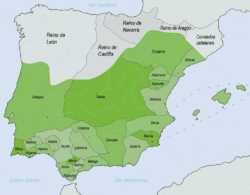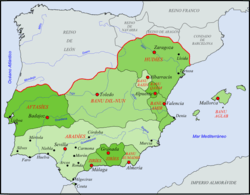Taifa

In the history of the Iberian Peninsula, a taifa (from Arabic: طائفة ṭā'ifa, plural طوائف ṭawā'if) was an independent Muslim-ruled principality, usually an emirate, though there was one oligarchy, of which a number were formed in Al-Andalus (Moorish Iberia) after the final collapse of the Umayyad Caliphate of Córdoba in 1031.
History
Rise
The origins of the taifas must be sought in the administrative division of the Umayyad Caliphate of Córdoba, as well in the ethnic division of the elite of this state, divided among Arabs, the more numerous Berbers, Iberian Muslims (known as Muladíes – a significant majority) and the Eastern European former slaves.
During the late 11th century, when the First Crusade waves were carving out their territories in the Jerusalem area, the Christians of the northern Iberian peninsula set out to take over the Muslim territories. The caliphate of Cordova, at this time among the richest and most powerful states in Europe, underwent civil war, known as fitna. As a result, it "broke into taifas, small rival emirates fighting among themselves."[1]
However, the political decline and chaos was not immediately followed by cultural decline. Intense intellectual and literary activity continued in some of the larger taifas.
There was a second period when taifas arose, toward the middle of the 12th century, when the Almoravid rulers were in decline.
During the heyday of the taifas, in the 11th century and again in the mid 12th century, their emirs (rulers) competed among themselves, not only militarily but also for cultural prestige. They tried to recruit the most famous poets and artisans.
Decline
Reversing the trend of the Umayyad period, when the Christian kingdoms of the north often had to pay tribute to the Caliph, the disintegration of the Caliphate left the rival Muslim kingdoms much weaker than their Christian counterparts, particularly the Castilian–Leonese monarchy, and had to submit to them, paying tributes known as parias.
Due to their military weakness, taifa princes appealed for North African warriors to come fight Christian kings on two occasions. The Almoravids were invited after the fall of Toledo (1085), and the Almohads after the fall of Lisbon (1147). These warriors did not in fact help the taifa emirs but rather annexed their lands to their own North African empires.
Taifas often hired Christian mercenaries to fight neighbouring realms (both Christian and Muslim). The most dynamic taifa, which conquered most of its neighbours before the Almoravid invasion, was Seville. Zaragoza was also very powerful and expansive, but inhibited by the neighbour Christian states of the Pyrenees. Zaragoza, Toledo, and Badajoz had previously been the border military districts of the Caliphate.
List of taifas

First period (11th century)
After the fall of the Caliphate of Cordoba in 1031, about 33 taifas were independent after the civil war and conflict in Al-Andalus. The strongest and largest taifa in this first period (11th century) were the Taifa of Zaragoza, Taifa of Toledo, Taifa of Badajoz and the Taifa of Seville. The only taifa which conquered most of the weak neighbours was Taifa of Seville under the Abbadid Dynasty ruler.
Al-Tagr Al-Adna (Central Portugal)
This region includes the Centro and Lisboa region of Portugal and Extremadura region of Spain.
- Badajoz 1013-1022/1034-1094 (Aftasid Dynasty); 1027-1034 (to Seville): 1094 (to Almoravids)
- Lisbon 1022-1034 (Banu Sabur Dynasty); 1034-1093 (Aftasids Dynasty)
Al-Garb (Southern Portugal)
This region includes the Alentejo and Algarve region of Portugal.
- Mértola 1033-1044 (Tayfurid Dynasty); 1044-1091 (to Seville)
- Saltés and Huelva 1012/1013–1051/1053 (Bakrid Dynasty); 1051-1091 (to Seville)
- Santa Maria do Algarve 1018-1051 (Harunid Dynasty); 1051-1091 (to Seville)
- Silves: 1027-1063 (Muzaymid Dynasty); 1063-1091 (to Seville)
Al-Tagr Al-Awsat (Central Spain)
This region includes the Madrid region and the provinces of Toledo and Guadalajara of Spain.
Al-Musata (Castilla La Mancha)
This region only includes the provinces of Ciudad Real, Albacete and Cuenca of Spain.
Al-Andalus (Southern Spain)
This region includes the Autonomous Region of Andalucia in Spain
- Algeciras: 1035–1058 (to Seville)
- Arcos: 1011–1068 (to Seville)
- Carmona: 1013–1091 (to Almoravids)
- Ceuta: 1061–1084 (to Granada)
- Córdoba: 1031–1091 (to Seville)
- Granada: 1013–1090 (to Almoravids)
- Málaga: 1026–1057/1058 (to Granada); 1073–1090 (to Almoravids)
- Morón: 1013–1066 (to Seville)
- Niebla: 1023/1024–1091 (to Seville)
- Ronda: 1039/1040–1065 (to Seville)
- Seville: 1023–1091 (to Almoravids)
Al-Tagr Al-A'la (Aragon and Catalonia)
This region only includes the provinces of Teruel, Zaragoza and Tarragona of Spain.
- Albarracín: 1011–1104 (to Almoravids)
- Alpuente: 1009–1106 (to Almoravids)
- Rueda: 1118–30 (to Aragon)
- Tortosa: 1039–1060 (to Zaragoza); 1081/1082–1092 (to Denia)
- Zaragoza: 1018–1046 (to Banu Tujib; then to Banu Hud); 1046–1110 (to Almoravids; in 1118 to Aragon)
Al-Xarq (Eastern Spain)
This region includes the region of Valencia, Murcia and Baleares.
- Almería: 1011–1091 (to Almoravids)
- Denia: 1010/1012–1076 (to Zaragoza)
- Jérica: 11th century (to Toledo)
- Lorca: 1051–1091 (to Almoravids)
- Majorca: 1018–1203 (to Almohads)
- Molina: ?–1100 (to Aragon)
- Murcia: 1011/1012–1065 (to Valencia)
- Murviedro and Sagunto: 1086–1092 (to Almoravids)
- Segorbe: 1065–1075 (to Almoravids)
- Valencia: 1010/1011–1094 (to El Cid, nominally vassal of Castile but allied to Banu Hud)
| History of Al-Andalus |
|---|
|
Muslim conquest (711–732) |
|
Umayyads of Córdoba (756–1031) |
|
First Taifa period (1009–1110) |
|
Almoravid rule (1085–1145) |
|
Second Taifa period (1140–1203) |
|
Almohad rule (1147–1238) |
|
Third Taifa period (1232–1287) |
|
Emirate of Granada (1238–1492) |
| Related articles |
Second period (12th century)
- Almería: 1145–1147 (briefly to Castile and then to Almohads)
- Arcos: 1143 (to Almohads)
- Badajoz: 1145–1150 (to Almohads)
- Beja and Évora: 1114–1150 (to Almohads)
- Carmona: dates and destiny uncertain or unknown
- Constantina and Hornachuelos: dates and destiny uncertain or unknown
- Granada: 1145 (to Almohads)
- Guadix and Baza: 1145–1151 (to Murcia)
- Jaén: 1145–1159 (Murcia); 1168 (to Almohads)
- Jerez: 1145 (to Almohads)
- Málaga: 1145–1153 (to Almohads)
- Mértola: 1144–1145 (to Badajoz)
- Murcia: 1145 (to Valencia); 1147–1172 (to Almohads)
- Niebla: 1145–1150? (to Almohads)
- Purchena: dates and destiny uncertain or unknown
- Ronda: 1145 (to Almoravids)
- Santarém: ?–1147 (to Portugal)
- Segura: 1147–? (destiny unknown)
- Silves: 1144–1155 (to Almohads)
- Tavira: dates and destiny uncertain or unknown
- Tejada: 1145–1150 (to Almohads)
- Valencia: 1145–1172 (to Almohads)
Third period (13th century)
- Arjona: 1232–1244 (to Castile)
- Baeza: 1224–1226 (to Castile)
- Ceuta: 1233–1236 (to Almohads), 1249–1305 (to Marinids)
- Denia: 1224–1227 (to Almohads?)
- Lorca: 1240–1265 (to Castile)
- Menorca: 1228–1287 (to Aragon)
- Murcia: 1228–1266 (to Castile)
- Niebla: 1234–1262 (to Castile)
- Orihuela: 1239/1240–1249/1250 (to Murcia or Castile)
- Valencia: 1228/1229–1238 (to Aragon)
Additionally, but not usually considered taifas, are:
- Granada: 1237–1492 (to Castile)
- Las Alpujarras: 1568–1571 (to Spain)
References
- ↑ Tolan, John (2013). Europe and the Islamic World: A History. Princeton: Princeton University press. p. 40, 39-40.
External links
- History of Spain: Disintegration of the Caliphate (1010–1260)
- Regnal Chronologies - Iberia: al-Andalus
- The Taifa Period